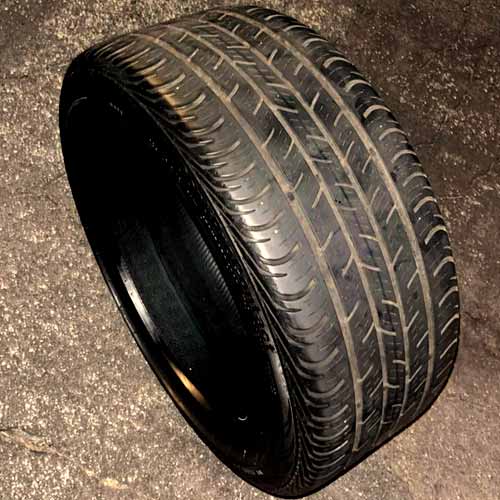Though it seems very weird at first, it’s not wise to just replace one tire with the ruined one. It’s recommended to replace all 4. But there are some ways, I can help you out. But you need to ask the right question, and that’s “How” can you replace just one tire.

The main reason why replacing a single tire is not so great is because the new tire would have a different tread depth and compound then the other 3 tires and this causes handling issues, uneven wear and high rolling resistance, so you spend more on the fuel money in the long run.
So how to replace tire and get away with all these negative things? Well, let’s find out.
If you must replace one tire:
If you have no other choice, and can’t replace all four tires at the same time, then there is a way you can work with a single new tire.
But note that it only works if:
- None of your tires are not worn more than 70% compared to new ones. (If the tread depth of a new tire is 10/32″, the 70% of it would mean, 7/32″, so the difference of 3/32″).
- This does not work for 4X4 tires, as they all get to wear at the same rate.
- If you have directional tires, swap the tires properly, maintaining orientation.
For your info: In order to measure tread depth, you can just use a penny (find how).
For FWD owners
On front wheel drive (FWD) the front tires are are responsible for both propelling the vehicle forward and providing steering input. Moreover, these front tires also carry slightly more weight of the engine, as it’s right above them.
All these factors cause them to wear faster.
So if you want to replace just one tire here do the following:
- Check the tread depth of all very accurately.
- Swap the front tires with the rear ones.
- Add the new tire to the front (preferably the one with slightly lower tread depth).
- Ensure that the tread depth difference between the new tire and the old one should be less than 70%.
- Adjust the optimal pressure PSI to all tires, (if you don’t know, what is it, look in the drivers door).
- Increase the pressure of the tire which is opposite the new tire, by 3 PSI.
Also after doing so, measure how much time it took for the tires to wear up to that level, and after running for the same amount of time, check the tread depth of all tires. It would be most like turn out similar. And you can then maintain the same amount of pressure on all tires.
The whole point is to close in the tread gap between the tires on the same axle. So you have to constantly check out the tread depth of all tires.
For RWD Owners
For rear wheel drive, the rear tires get to wear off faster so in this case if you want to replace a single tire.
- Make sure you measure the tread depth of all correctly.
- Swap the rear ones with the front tires.
- Replace the new tire to the rear.
- Follow the same steps after as listed for the FWD.
Note: I don’t recommend this, but its just a workaround. A better option would be to just replace your front tires (without swapping with the rear ones first). Also make sure you read my guide on how to reduce tread wear.
Replacing 2 tires instead of 1
Replacing 2 tires don’t make you worry about trying to close in the tread gaps between the tires so it’s a much better option, no doubt.
But still you should keep in mind that none of the tires you have are not worn more than 70%.
And yes it a whole another scenario for directional tires, but other than that, for front wheel drive tires, simply swap the new ones with the front ones.
And for RWD, simply add the new tires on the back and you are good to go.
For 4WD, although even replacing 2 tires are not recommended, you can only do this temporarily. Just swap the most worn tires with the new ones. But there’s one more thing you can do.
Look for Shaving Service
If your tires are fairly new, there are companies that charge you a little and make all your tires of same tread depth.
Its a much cheaper option, and I guarantee, its not going to cost you more than buying 2 or all 4 tires.
Summing Up
So overall it’s not recommended to replace just one tire. But if you dig in deeper, the reason is tread depth difference, which can cause uneven wear patterns.
You want to make sure that the tread depth of all tires are as close as possible.
So if your tires are fairly new, and there is very little tread depth difference between them, you can simply swap the tire without worry ting too much.
Though its still best to contact the shaving companies near you, so that your tires offer the best performance and safety values.